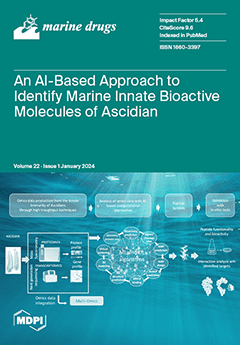Macroalgae, particularly red seaweeds, have attracted significant attention due to their economic and health benefits.
Chondrus, a red algae genus, despite its economic importance, seems to be undervalued. Among all its species,
Chondrus crispus has been meticulously documented for its biological properties,
[...] Read more.
Macroalgae, particularly red seaweeds, have attracted significant attention due to their economic and health benefits.
Chondrus, a red algae genus, despite its economic importance, seems to be undervalued. Among all its species,
Chondrus crispus has been meticulously documented for its biological properties, and little is known about other species. No comprehensive review of the biological properties of this genus has been acknowledged. Thus, this review aimed to summarize the available information on the chemical constituents and biological properties of a few selected species, including
Chondrus crispus,
Chondrus ocellatus,
Mazzaella canaliculata, and
Chondrus armatus. We compiled and discovered that the genus is offering most of the important health-promoting benefits evidenced from in vitro and in vivo studies focused on antimicrobial, immunomodulation, neuroprotection, anti-atopic, anti-inflammatory, anti-viral, anti-diabetic, cytoprotective, antioxidant, anti-coagulation, nephroprotective, anti-tumor, and anti-venom activity, which speaks about the potential of this genus. Data on clinical studies are limited. Further, around 105 chemical constituents have been reported from
Chondrus spp. Given its significance, further investigation is warranted, in the form of meticulously planned cell, animal, and clinical studies that concentrate on novel health-enhancing endeavors, in order to unveil the full potential of this genus. The review also outlines challenges and future directions.
Full article






